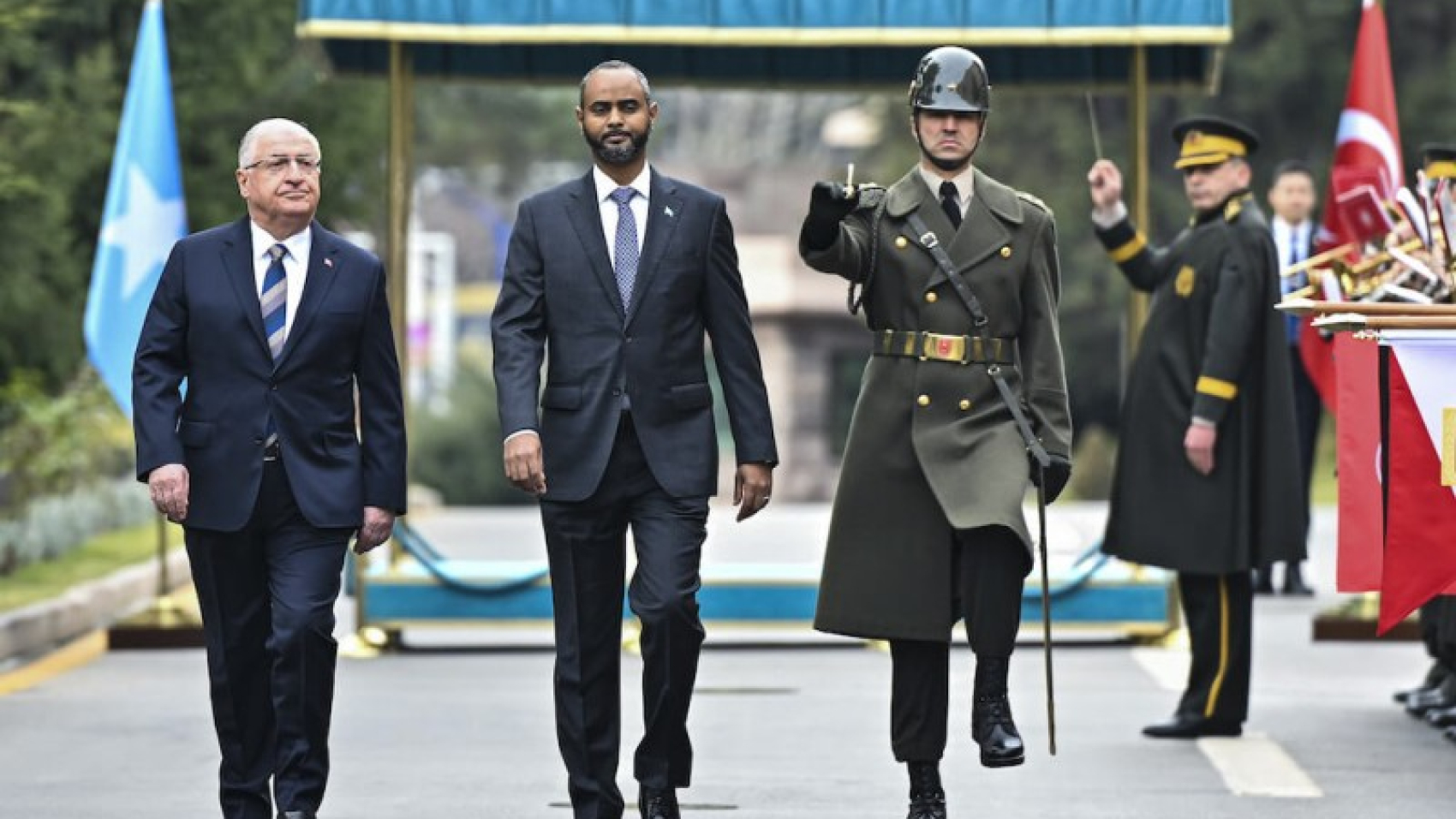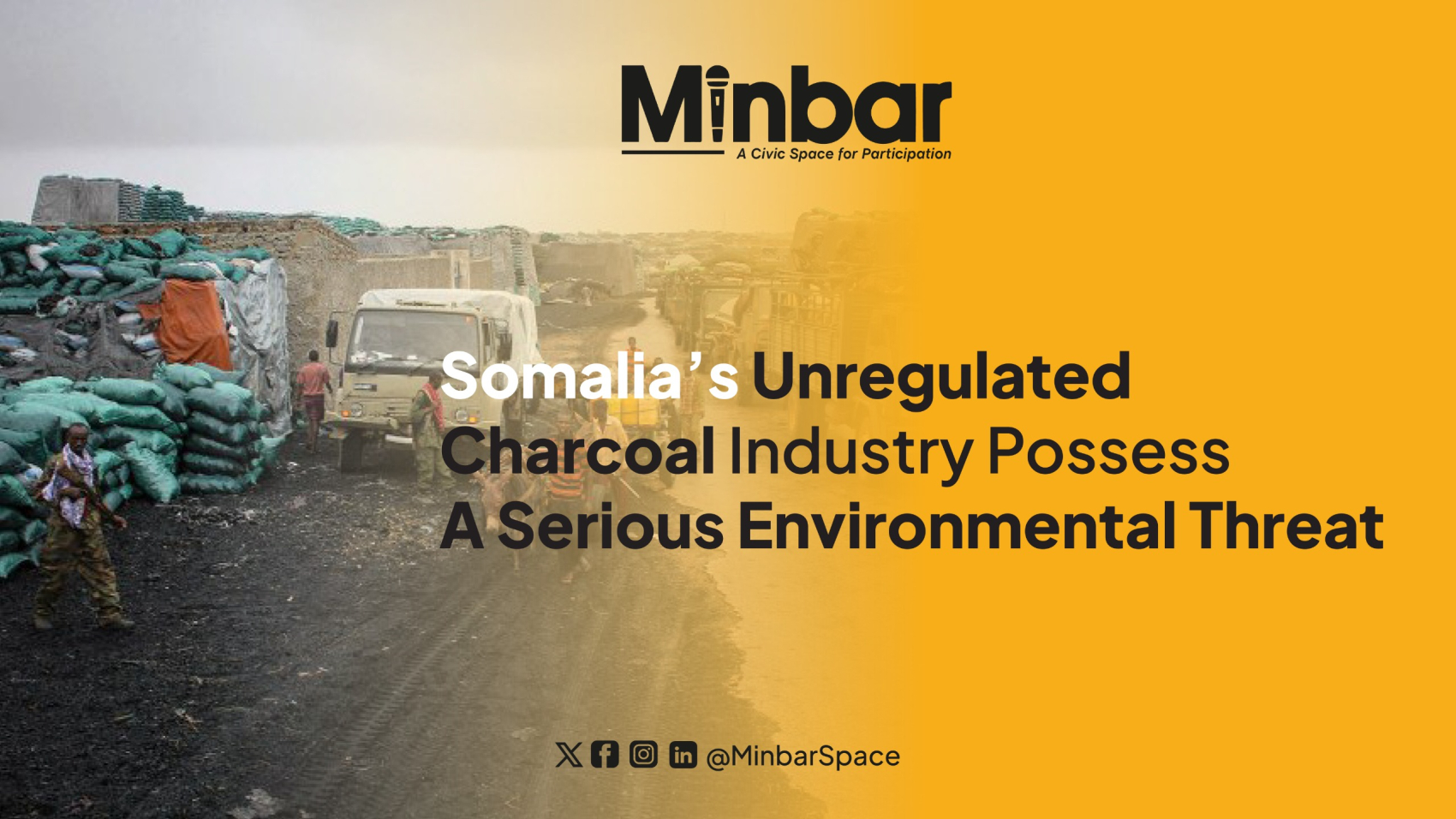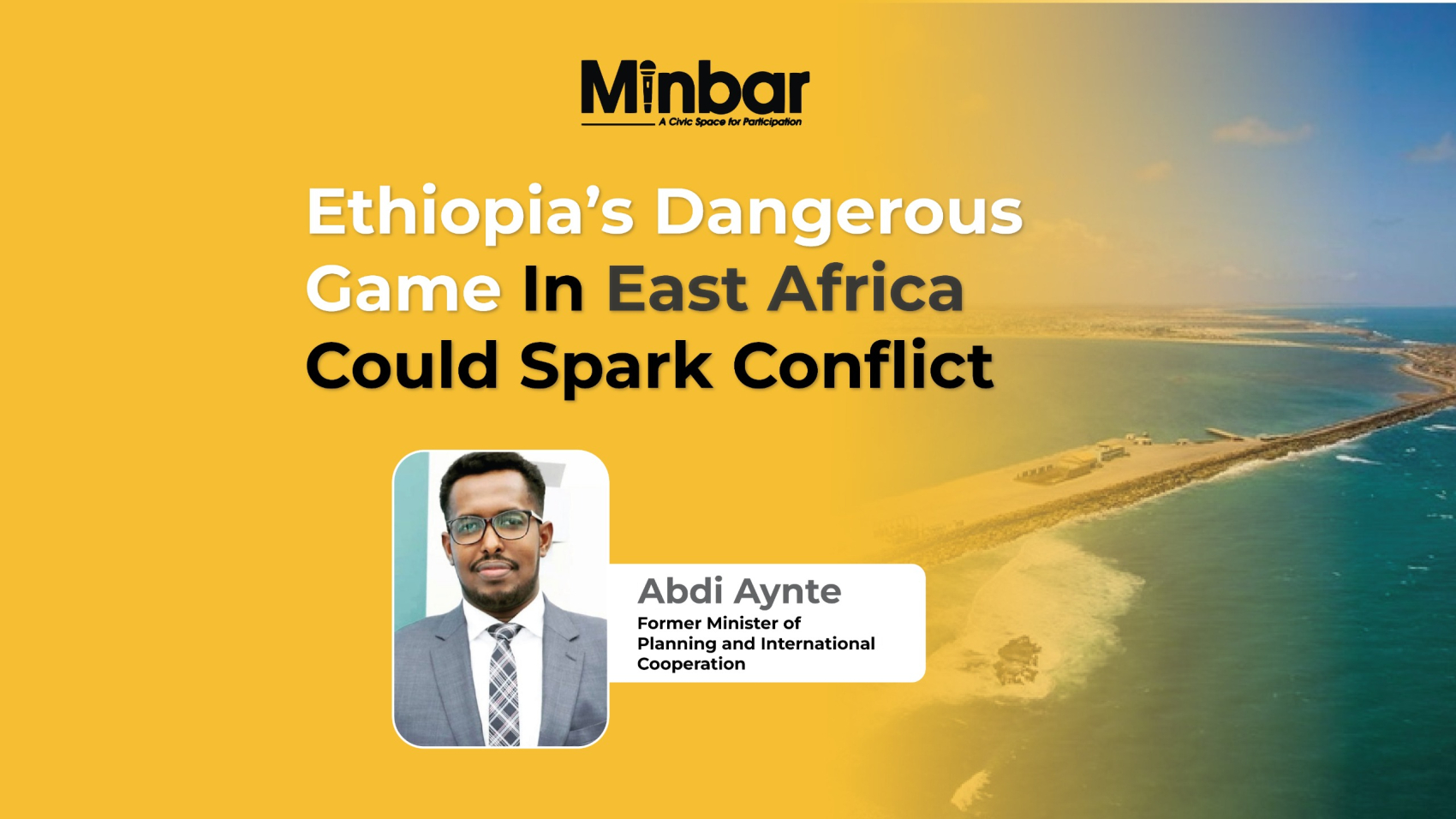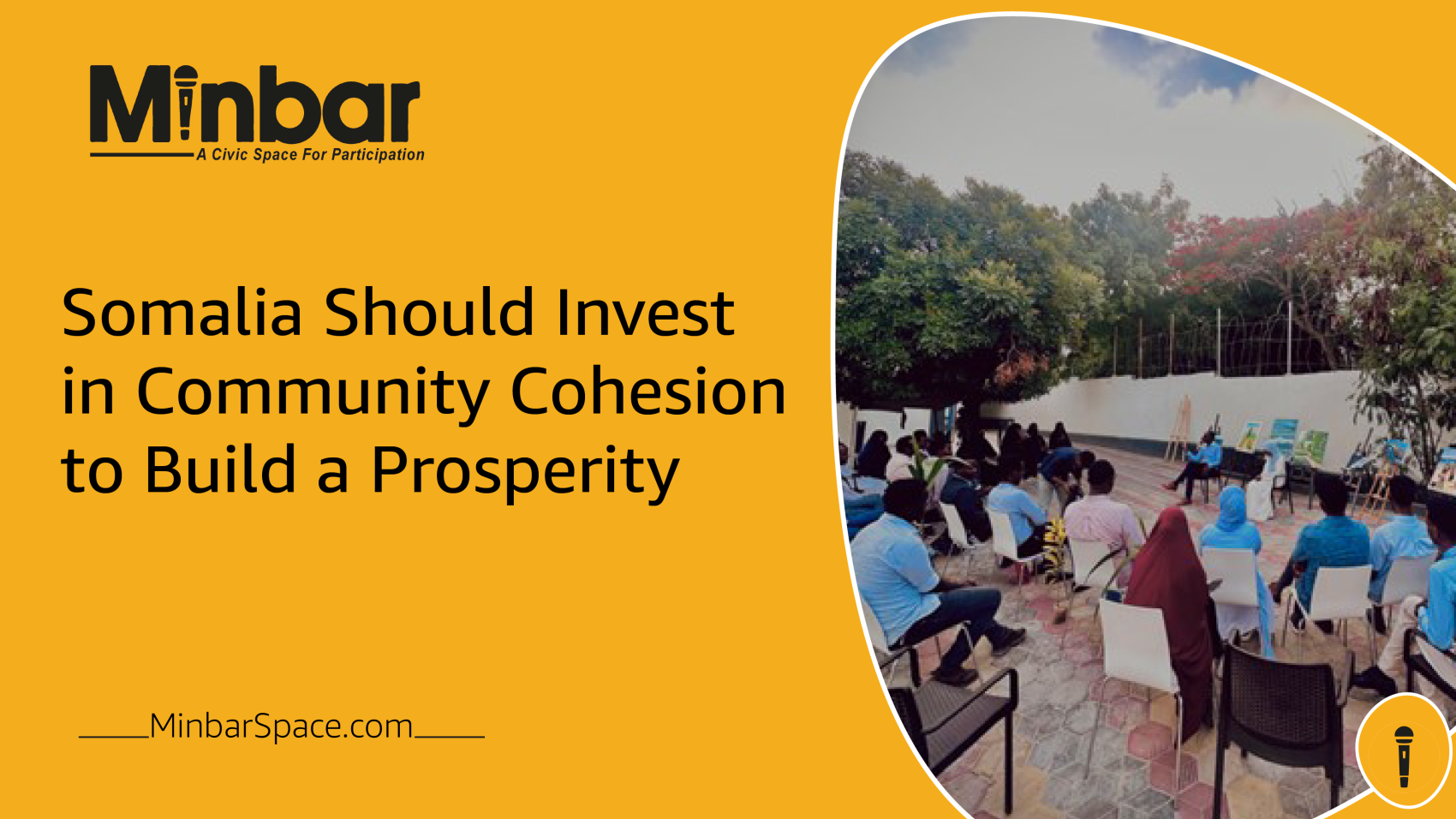Turkey has a multi-dimensional presence throughout the Horn of Africa and repeatedly emphasizes the paramount importance of regional peace.
Somalia’s unregulated charcoal industry possess a serious environmental threat
Recently, disturbing images of trucks loaded with chopped trees for the charcoal business have sparked public outrage.
Ethiopia’s dangerous game in East Africa could spark conflict
A recent Ethiopian agreement with breakaway Somaliland is in breach of Somali sovereignty and threatens to destabilise the whole region.
Time to Work for a New Momentum in Somalia–Türkiye Relations
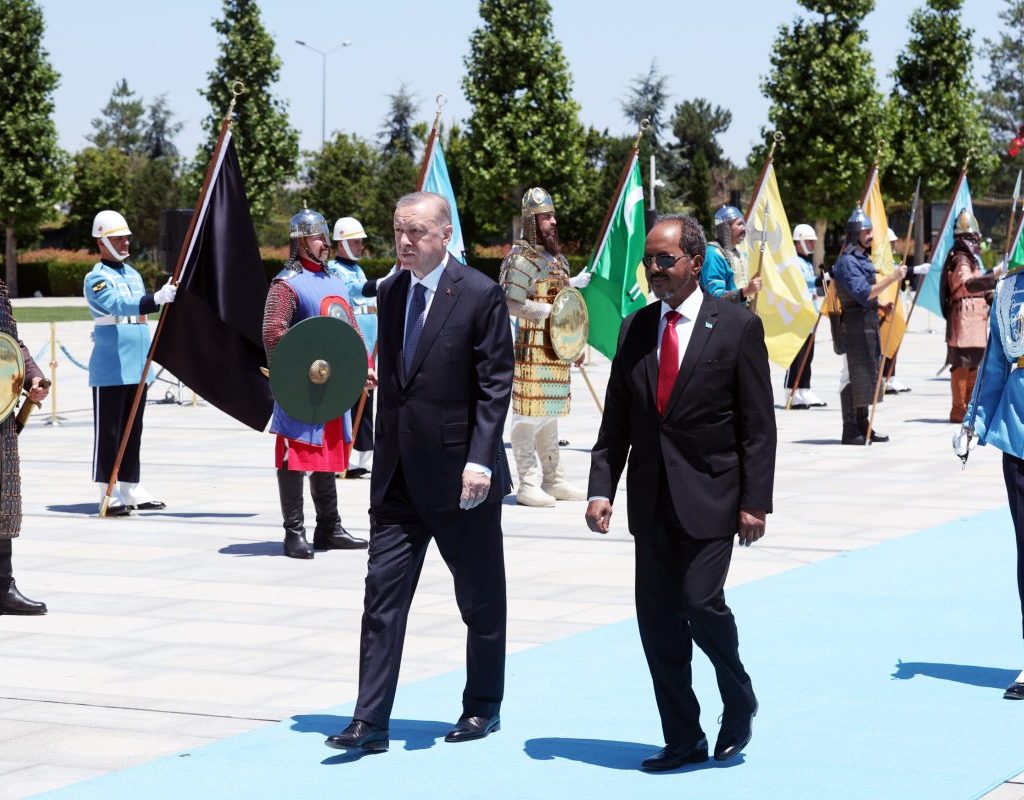
President of Türkiye, Recep Tayyip Erdogan (L) and Somali President Hassan Sheikh Mohamud (R) [Anadolu Agency].
The 12-years-old Modern relations between Somalia and Türkiye continues Diplomaticallyas the two brotherly nations take new steps in bilateral cooperation and people to people relations.
Somalia and Türkiye enjoy cordial relations, despite geographical distance brotherly nations have distinct culture and traditions based on our rich historical heritage. While diplomatic contacts go back to 16 century between the Ottoman Empire and the Somali Sultanates.
However, Somalia’s relations with Türkiye weakened when the Ottoman Empire fell apart and the Republic of Türkiyewas established in 1923. The newly founded Republic of Türkiye’s adoption of a western-oriented foreign policy, as well as the colonial powers’ separation of Somalia, were among the influences that affected the historical connection.
Later in the 1960s, Türkiye’s foreign policy started to engage with African states and pursued an open policy towards the African continent, thus, paved the way for Somalia-Türkiye relations to resume. Somalia opened its embassy in Ankara in 1976, whereas Türkiye also established its embassy in Mogadishu only after three years in 1979. Yet, this relationship did not last long as Somalia state collapsed in 1991 and the country went into a harsh civil war.
Following the fall of the Somali government in 1991 and the subsequent complex civil war, the Somali government was reconvened in 2000. The Somali government embarked on a path to normalize its affairs and restore its place in theinternational community at the United Nations. The successive governments had an enormous challenge in restoring law and order to Somalia after a protracted civil war and terrorism.
President Erdogan’s historic visit
On August 19, 2011, Turkish President Recep Tayyip Erdogan, then prime minister paid a heroic trip to Somalia. The Turkish prime minister was the first by a non-African leader to visit Somalia since the eruption of the civil conflict in 1991.
One of the worst famines in recent memory devastated Somalia and much of East Africa in 2011. The people of Somalia was severely affected by the famine due to the country’s weak state infrastructure and the imminent threat of Al-Shabaab terrorism. International humanitarian organizations and the general population were disturbed by the starvation and mortality.
The visit of president Erdogan was essential in coordinating and advancing international efforts towards helping Somalia amid the humanitarian crisis. The trip itself became an important symbol of Turkish humanitarian efforts and desire to work with underdeveloped African nations that did not possess enough governmental capacity to confront with natural and man-made calamities. The aim of Türkiye in Somalia was to provide emergency assistance to people who were affected by the drought, which was the most severe in Africa’s eastern region in 60 years.
From humanitarian assistance to development cooperation
The visit and establishment of the Turkish Embassy in the country also marked the beginning of stronger ties between Mogadishu and Ankara. These ties have expanded beyond diplomatic relations and remain apparent in other socio-economic and humanitarian areas.
In 2011, Türkiye launched its largest and effective humanitarian aid mission withe the Turkish Cooperation and Coordination Agency (TIKA), the Turkish Red Crescent (Kızlay), and civil society organizations. Since then, it has continued to provide humanitarian and development assistance in Somalia. These organizations have provided emergency response, development projects, technology transfer, and scholarships Somali students to study in Türkiye.
More foreign embassies wereopened in the country’s capital city, and the country continues to grow, drawing investment and returning Somali expatriates and diaspora communities.
Türkiye’s humanitarian assistance and emergency response to every disaster that has took place in Somalia has earned it a special position in the hearts and the minds of the Somali Nation.
Both Türkiye and Somalia emphasised the importance of shared historical and cultural links in improving bilateral relations and exploring new avenues for collaboration in other areas. Somalia became Türkiye’s key entrance to the Horn of Africa. Last August 19, 2023, marked the 12th anniversary of the resumption of relations between Türkiye and Somalia.These relationships, which have been strengthened and grown in numerous areas, are poised to deepen in the future.
Mutual high-level visits have contributed to strengthening of our ties. I was also pleased and honoured to contribute and Serve our country as the Political advisor of the Embassy of Federal Republic of Somalia to Türkiye in 2020. The first contact of political consultations held in May 2007, when Prime minister Erdoğan met with the former President of the Transitional Federal Government of Somalia Abdullahi Yusuf at the sidelines of the AU meeting in Addis Ababa and expressed Türkiye’s interest to contribute the statebuilding process of Somalia. After President Sharif Sheikh Ahmed came to power, President Sharif visited Türkiye three times between 2009 and 2011. Timing of our first political consultations was also meaningful, as it took place when the state building of somalia needed relaible partner like Türkiye and advanced right after the intervention of the humanitarian crisis in Somalia that was meant to express the solidarity of Türkiye with Somalia in difficult times. . both countries set up their Embassies consecutively in 2011 and in 2012, As a sign of friendly partnership, both countries establishedInterparliamentary Friendship Groups and are looking forward to further strengthen our bilateral relations at the parliamentarian level and collaborating in reviewing and passing existing agreements for the development of our nations.
A CALL TO REINVIGORATING OUR BILATERAL RELATIONS
Development cooperation between Somalia and Türkiye is multi-tiered, and includes Security,economic, social and infrastructural partnerships. The Türkiye-Somalia Partnership is founded on on a win-win and equal partnership basis.Türkiye aims to contribute to the progress of Somalia and seeks to have an equal partnership , which will allow both sides to maximize their national interests.
On security Front, in May 2010, the Somali and Turkish governments signed a military training agreement.Enforcement of the pact officially began in November 2012. Turkey opened a military training academy in Somalia, its largest overseas military training facility, on Sept. 30, 2017. The academy plays a crucial role in building a professional army for Somalia with the training and deployment of special forces that are playing a crucial role in restoring Rule of law,fighting and defeating the Al-Shabab terror group and in the near future will secure territorial integrity of our country. While we are grateful to the African Union Mission that has provided security in the last 15 years, its current mandate under the AU Transitional Mission in Somalia (ATMIS) expires in two years. Today, 12 years on, the Somali national armed forces is stronger and more advanced as a result of that cooperation.
On Trade Matters, Trade gates between the two countries have opened. Turkish companies have begun investing in Somalia, and some have won high-level contracts to operate the Mogadishu port and the airport. Meanwhile, many Somali businesspeople have opened businesses in Turkey, and hundreds more have made Türkiye a higher education and health tourism destination. both Countries signed a pact to boost their strategic economic partnership. The countries also inked a memorandum of understanding on fishing and fisheries, The agreement would maintain bilateral economic ties and bolster strategic cooperation in the years to come.both countries should carry through 2016 memorandums of understanding in such areas as energy, mines, electricity, higher education, agriculture, and maritime affairs. Somalia is a country dependent on imports. Our trade volume were 2 million dollars back in 2003 and increased by 31 percent to reach 363 million dollars last year. While Turkey’s investment in Somalia stands at over $100 million, This figure forms a foundation to prompt bigger cooperation in the days to come.the existence of business and investment opportunities coupled with the recent bilateral efforts for economic cooperation and the willingness of authorities to work together can predict positive future economic collaboration.
While Turkiye’s win-win and equal partnership are widely recognized, Somalia can also offer reciprocal engagement to Türkiye. Turkiye-Somalia partnership can progressively expand into full-fledged bilateral trade including foreign direct investment.
Somalia is a country with untapped natural resources, and some preliminary explorations show that the country has a large number of gas, oil and minerals deposits. It is estimated that the total oil in the Indian Ocean waters off of Somalia is about 100 billion barrels. This opens up new options for Turkiye’s public and private investors to capitalise on Somalia’s favourable investment climate.
In deepening our mutual partnership, both countries should put forward a reciprocal expanded trade in which Turkiye exporting firms can tap into our economy, while Turkiye provides favoured market access for Somali producers working in agriculture, livestock, frankincense, fisheries, leather industry, and other sectors. on the other hand, Export development through Turkish assistance, and can enable Somali companies to operate in the global market.
Another advantage Somalia can provide Türkiye is the enormous investment potential in our blue economy. Although Somalia has Africa’s longest ocean strip, it’s ongoing civil war, which has lasted for almost a quarter of a century, put an end to fishing on one of the world’s most beautiful coastlines. Turkey helped to build a Fisheries Training School in Somalia.
Teaching the Somali society how to fish again through this will be a lasting investment in the economic sustainability of the country by creating employment, restarting a valuable food sector, and even developing a fisheries industry.
Both countries aim to strengthen their existing ties and explore new avenues of cooperation. Our ancestors almost six centuries ago, took the first steps to bring closer our two nations. Today, built on our past, we can make our common future brighter.The future holds immense potential for these two nations to deepen their bond and embark on a shared journey toward a brighter and more prosperous future.
Somalia Should Invest in Community Cohesion to Build a Prosperity
What is the common obstacle in our society that obstructs our recovery, regardless of religious, cultural, or linguistic diversity?
Somalia has grappled with formidable challenges in recent decades, encompassing political instability, conflict, poverty, and economic limitations. Nonetheless, the nation holds vast potential, particularly within its youthful population, natural resources, and strategic location. To revive Somalia, a clear vision and pragmatic solutions must emerge from the grassroots.
Over the past thirty years, Somalia has been entrenched in conflict, eroding the government’s authority. The struggle persists against militant groups, clan factions, and terrorist organizations claiming to represent Islam. Despite these adversities, the federal government strives to enhance security, economic prospects, and debt alleviation. Moreover, government restructuring is underway. However, little attention has been given to social reconstruction and community development. This apathy extends to government bodies, private organizations, political parties, and interest groups, with only a handful prioritizing these critical endeavors. Regrettably, the community remains largely unaware.
Community development isn’t a simple task achievable by a single entity, be it government or individual. It necessitates collective efforts. So, what exactly is the problem? What actions should be taken? And who bears the responsibility?
The issues we face are multifaceted, stemming from various facets of society driven by personal values, needs, and preferences. These issues are often neglected, despite their presence. They encompass:
- Outdated Political Culture: Somalia’s political culture and socialization processes hinder progress. The absence of a strong central government and the dominance of tribalism are major factors behind Somalia’s political stagnation. Corruption plagues the government, eroding trust. The political system’s complexity, marked by inconsistent socialization practices, creates an unpredictable and chaotic environment.
- Religion and Conflict: Religion holds immense significance in Somalia but has also fueled destructive conflict instead of fostering order and support.
- Tribalism’s Stranglehold: Tribalism has long perpetuated discrimination, hate crimes, and poverty, dividing clans and perpetuating violence.
- Educational Shortcomings: Somalia’s subpar education system limits the youth’s opportunities, stifling innovation and progress and leaving citizens ill-equipped to understand their rights and responsibilities.
Despite these challenges, Somalia can overcome them. The core issues revolve around a political system and culture that prioritize tribal affiliations over democratic principles, rule of law, and equal opportunities. Furthermore, the lack of quality education impedes human development and economic participation. Addressing these issues necessitates investment in infrastructure, job creation, and entrepreneurship, thus transforming the informal economy into a formal one.
To rebuild Somalia’s communities, the following strategies are imperative:
- Invest in Education: Expanding access to quality education, particularly for the youth, is paramount. Increasing the number of teachers, constructing schools, and providing learning resources will enhance literacy and opportunities over time.
- Economic Revitalization: Encouraging foreign investment, offering small business loans, workforce development, and improving infrastructure (energy, water, roads, technology) are key steps. Prioritizing private sector job growth and entrepreneurship will stimulate the formal economy, benefiting youth and families.
- Establish Democratic Values: Promoting equality, civic engagement, free speech, and fair legal processes can shift the culture toward democracy and inclusivity. A representative government upholding the rule of law is critical.
- Empower the Youth: The youth represent Somalia’s brightest hope. Developing youth leadership in civil society, business, and government is crucial. Their energy, ideas, and passion should be nurtured and supported.
In society, factors such as culture, education, language, ethnicity, and religion profoundly shape citizens’ lives. Embracing diversity can create a harmonious environment and a stable community. Steps must be taken to seize this opportunity.
Change Through Trade? East African Community Starts Accession Negotiations with Somalia
The East African Community (EAC) is one of the fastest-growing regional economic blocs in the world. It currently comprises seven partner states, including Congo (since 2022), the Republic of Burundi, Kenya, Rwanda, South Sudan, Uganda and Tanzania. The EAC is home to approximately 283 million people and covers approximately 4.8 million square kilometres of land. The gross domestic product of the Community is currently about 305.3 billion USD.[1] The basis for the cooperation is an international treaty that came into force on 7 July 2000.[2] The founding countries were Kenya, Tanzania and Uganda. However, the EAC’s enlargement and deepening strategy has gained considerable momentum recently. Now Somalia could become the eighth member state of the EAC soon. At the EAC Heads of State and Government meeting on 6 June 2023, Somalia’s application for membership was officially approved, and the EAC Council and Secretary were mandated to conduct accession negotiations with Somalia. However, what does this step mean for both sides?
The East African Community: A single market based on the European model?
The EAC is, first and foremost, a customs union and a community for creating a common internal market (organised in a market economy), Art. 2 of the founding treaty.[3] To achieve this goal, membership is linked to certain preconditions. For example, the partner countries must respect the fundamental values of the EAC, commit to good governance, the rule of law and respect for human rights. For Somalia, its neighbours would recognise membership that it has achieved specific standards. However, it is also about establishing a free-market economy and basic social security systems. The Community aims to create peaceful coexistence and coordinate on particular issues of foreign and security policy, economic and security policy vis-à-vis third countries and internally. In addition to the usual political bodies, the EAC has created a Legislative Assembly, a Development Bank and a Court of Justice. The latter has to review the partner countries’ compliance with their treaty obligations. More than 150 articles define the tasks of the other organs and the legal effect of decisions of the Court of Justice. In addition, various additional protocols define further guidelines for the Community’s policy. The parallels to the structures of the early EU are, therefore, very clear.
The Expansion of the EAC: a win-win situation
For the EAC, Somalia’s accession could therefore become another important milestone. With over 3,000 km of coastline, Somalia is considered one of the most important logistical hubs to the European, Asian and Arab regions. It could thus play an essential role in connecting large markets and intra-regional trade.[4] However, the country in the Horn of Africa would be more than just a gateway for the other partners. Besides a large livestock economy, fish and frankincense, the country has excellent agricultural potential. Moreover, raw materials such as oil and gas are suspected offshore and onshore. Somalia could therefore become an important economic partner for the EAC.
For Somalia, it could also be an important step. Not only would the country take a further step towards becoming a full member of the international community again. The step would also have an important function within the regional stability policy in East Africa. For decades, the focus was on the conflicts between Somalia and its neighbours. Regional integration could be an important signal that this era is finally over. Nevertheless, Somalia also has a considerable economic interest. Not only did frequent border closures affect trade, and they were a popular means in the past to either heat up or cool down the mood between the countries. Tariffs and other import restrictions have also led to high food, consumption and energy prices in Somalia. Integration into the EAC can therefore bring the government under President Dr Hassan Sheikh Mohamud a vital success in improving living conditions in the country.
For success, both sides need reforms
For these high mutual expectations to be fulfilled, however, the existing partner countries, as well as Somalia, must be prepared to engage in regional cooperation in the spirit of the treaties, which has unmistakable borrowings from the European Union. The EAC’s record so far is mixed. It is true that, at least superficially, a uniform customs policy for the internal market has been achieved, and a uniform External Tariff (CET) has been established vis-à-vis third countries. Similarly, various additional protocols have been adopted to deepen economic cooperation between the partner states, and a monetary union[5] has been envisaged.
However, despite these clear objectives and many political decisions at the highest level, the EAC has repeatedly encountered difficulties implementing these principles. For example, there have been delays in ratifying the decisions on intensified economic cooperation and monetary union, and individual partner states have created numerous new hurdles to trade within the EAC. In the past, the countries’ national economic strategies often counteracted the interests of the Community. In 2014, for example, there was a “Buy Uganda, Build Uganda” strategy. However, similar strategies also existed in Rwanda and Kenya. In Tanzania, there was a stipulation in 2016 that regional products should be preferred in national tenders. Some partner states have also allowed exceptions to the uniform customs tariff for imports from third countries in order to support national industries. These contractual exceptions, initially intended for emergencies, have been used so often that they have become more standard than exceptional in the EAC. In doing so, however, they disavow the implementation of common protocols and objectives to exempt, in particular, the agricultural and extractive sectors from the liberal rules of the Community. However, if one takes these two sectors out of the overall equation, comparatively few goods remain for EAC regional trade. The EAC, therefore, not infrequently appears like a paper tiger whose goals are more ambitious than its will to implement them.
Joining the EAC is part of “Soomaali Heshiis Ah. Dunidana Heshiis la ah[6]”- strategy from President Dr Hassan Sheikh Mohamud
Joining the EAC is nevertheless a good idea for Somalia. It opens markets in principle and in both directions. On the one hand, Somalia can hope for falling food prices, not least because its own fallow agriculture can hardly ensure the country’s self-sufficiency, and the elimination of export duties by the neighbouring states will lower prices. Accession would be less of a problem for its livestock industry, which in any case, primarily supplies the Arab world. On the other hand, accession is essential for Somalia’s medium- and long-term positioning as a logistics location as a gateway to and from East Africa. International investors could thus export their goods via Somalia to a market of almost 300 million people. On the political side, it would also be not only a crucial interim success but also a commitment on the part of the Somali government to continue on the path of stability, market economy and security. As stated above, the EAC is also a community of values in terms of good governance and the rule of law. In this respect, accession has also been an important part of the president’s political reconciliation strategy with his neighbours.
The European Union should cooperate more with EAC and support Somalia’s accession
Precisely because Somalia brings these potentials to the EAC, it can become a driving force for deeper economic integration. Somali business people are considered particularly capable and skilful. They will quickly discover the potential of regional and intra-regional trade for themselves. The European Union should accompany and actively support the accession process. Not only does it have a vital interest in having an intensive trade with the large internal market of the EAC, but the national egoisms described above also accompany the history of the emergence of the European internal market. In Europe, mechanisms to ensure economic equality of opportunity in all parts of the EU calmed the discussions about distributive justice within the Community.[7] In addition, the strengthening of the ECJ and its acceptance in the member countries were decisive in counteracting ever-new obstacles to the free movement of goods, workers, services and capital. Here, the EU could provide important support through experience transfer. Germany could contribute its experience and expertise, e.g. in the constitutional opening clause of Article 23 GG in supranational entities, to the current constitutional review.
Therefore, the government under President Dr Hassan Sheikh Mohamud should be congratulated on starting accession negotiations. The term change through trade takes on a new meaning here. Accession to the EAC creates the basis for economic success after the long struggle against Al Shabab. Somalia and the entire region are to be expressly wished this!
Baladweyne: Between Adversity and Resilience
Nestled in the heart of Somalia, Baladweyne stands as a town renowned for its agricultural prowess and the breathtaking beauty of its fertile lands. However, amidst its natural splendor lies a formidable challenge that tests the mettle of its inhabitants year after year—the recurring floods that bring both destruction and resilience to this remarkable community. This article sheds light on the captivating story of Baladweyne’s defiance amid cyclical and catastrophic humanitarian situation.
The Dual Adversities
Baladweyne’s battle against recurring floods illuminates the dual adversities faced by its inhabitants—an unyielding force of nature and the consequential human suffering.
Unyielding Force of Nature
As the rainy season arrives, Baladweyne’s landscape transforms into a tumultuous scene of rising waters and surging currents. The swelling of the Shabelle River presents a formidable challenge, testing the resilience of the town’s protective measures. While Baladweyne’s agricultural potential lies in the richness of its soil and the blessings of ample water supply, the same water becomes a double-edged sword when it exceeds its banks, breaching river embankments, and inundating homes, farmland, and infrastructure. Nature’s power, while awe-inspiring, leaves devastation in its wake.
Unspeakable of Human Suffering
Beyond the physical destruction lies the profound human suffering endured by the people of Baladweyne. Displaced from their homes, families seek refuge in makeshift camps or rely on the generosity of relatives. Basic necessities such as clean water, sanitation facilities, and healthcare become scarce commodities, heightening the vulnerability of the community. The loss of crops and livelihoods plunges many into a spiral of poverty and food insecurity, as dreams are shattered and hopes diminished. Yet, amid these adversities, the indomitable spirit of Baladweyne shines through.
Overcoming Challenges
The path to resilience for Baladweyne lies in comprehensive strategies that address both the unyielding force of nature and the consequential human suffering.
- Mitigating the Unyielding Force of Nature
- Strengthened River Embankments: By fortifying the river embankments, Baladweyne can better withstand the force of floodwaters, minimizing breaches and reducing the impact on homes and infrastructure.
- Enhanced Drainage Systems: Upgrading the town’s drainage infrastructure will facilitate the efficient flow of water during flood events, preventing waterlogging and reducing damage.
- Resilient Housing Solutions: Promoting the construction of flood-resistant housing designs can provide safer and more secure homes for the community, minimizing the risk of damage and displacement.
- Alleviating Consequential Human Suffering
- Adequate Temporary Shelter and Aid: Establishing well-equipped temporary shelters and distribution centers will provide immediate relief to displaced individuals, ensuring access to essential items such as food, clean water, and medical supplies.
- Healthcare and Sanitation Facilities: Strengthening healthcare services and sanitation facilities in Baladweyne will address the increased health risks associated with flooding, safeguarding the well-being of the community.
- Sustainable Livelihood Support: Implementing sustainable livelihood programs, including agricultural training and income-generating initiatives, will empower the community to rebuild their lives, restore economic stability, and foster long-term resilience.
A Joint Effort to Resilience
In embarking on the journey towards resilience, Baladweyne requires a collective and concerted effort from all stakeholders involved. It is essential for the Somali government and the Hirshalle state to recognize the profound impact that recurring floods have on the lives of Baladweyne’s inhabitants. Amidst the challenges faced by the town, it becomes apparent that the people are relying on their leaders to guide them towards a brighter future.
However, it is disheartening to observe that the needs of the community often go unnoticed or unaddressed. Baladweyne, with its rich agricultural heritage and its resilient people, deserves more attention and support from the authorities. The collaborative path to resilience must begin with a renewed commitment from both the government and the Hirshalle state to prioritize the well-being and future prospects of Baladweyne’s inhabitants.
To foster collaboration, it is crucial to establish open lines of communication and engage in meaningful dialogue with the local community. By listening to the concerns and experiences of the people, policymakers can gain a deeper understanding of the challenges they face and the solutions they envision. This inclusive approach will empower the community and foster a sense of ownership over the resilience-building process.
Moreover, collaboration should extend beyond the government and the state. Partnerships with humanitarian organizations, non-governmental organizations (NGOs), and international entities can bring valuable expertise, resources, and funding to support Baladweyne’s journey towards resilience. These partnerships can facilitate the implementation of comprehensive plans that address infrastructure development, disaster risk reduction, livelihood support, and capacity building.
The collaborative efforts must prioritize the following:
- Empowering Local Communities
- Infrastructure Development
- Livelihood Support and Economic Empowerment
- Strengthening Healthcare and Social Services
- Environmental Conservation and Natural Resource Management
Way Forward
By embracing a collaborative approach, the Somali government, the Hirshalle state, and other stakeholders can demonstrate their commitment to the people of Baladweyne. It is imperative to forge partnerships that foster trust, transparency, and inclusivity, ensuring that the voices and aspirations of the community are heard and incorporated into resilience-building efforts. Only through this collaborative path can Baladweyne overcome its challenges, restore hope, and pave the way for a brighter and more resilient future.
What is the Future for Somali’s 4.5 System?
Over the last three decade, the glue that has been holding Somali’s political system has been 4.5 power-sharing formula. This system was conceived by warlords in earlier days of the conflict and it has been dubbed as the most evil-genius piece of legacy by the warlords. In this short piece, I will try to shed light on the origins, its ups and downs and chart way forward. My main aim is to reflect and set debate in motion for the future of this 4.5 system.
